Transform your website! Discover 5 simple steps to WCAG 3.4 success: Conduct an audit, implement inclusive design, ensure clear navigation, prioritize multimedia accessibility, and engage in continuous monitoring. Elevate accessibility effortlessly!
Elevate website accessibility with Hurix Digital. Follow 5 easy steps to WCAG 3.4 success. Contact us now to know more!

Understanding Website Accessibility
Website accessibility is crucial in ensuring that all users, regardless of their abilities, can effectively navigate and interact with your site. This commitment enhances user experience and broadens your audience reach, making your site more inclusive and welcoming.
Why Website Accessibility Matters
Research indicates that approximately 15% of the global population experiences some form of disability. By prioritizing web accessibility, you cater to this substantial segment of users, fostering inclusivity and equality. Moreover, search engines favor accessible websites, which can improve your site’s ranking and visibility.
Key Aspects of Website Accessibility
To achieve effective website accessibility, consider these essential elements:
-
Color Contrast: Ensure sufficient contrast between text and background. A ratio of at least 4.5:1 for normal text and 3:1 for larger text helps users with visual impairments read content comfortably.
-
Concise Labels: Clear labels for form fields and buttons assist screen readers in delivering precise information, enhancing the overall user experience.
-
Keyboard Navigation: Many users rely on keyboard navigation. Ensure all interactive elements can be accessed solely through the keyboard for users with motor disabilities.
-
Descriptive Alt Text: Meaningful alt text for images provides context for users who cannot see them, benefiting those using screen readers.
-
Logical Content Structure: Organize content with appropriate headings for easier navigation, aiding users employing screen readers.
Implementing Accessibility Best Practices
To enhance your website’s accessibility, consider these best practices:
- Regularly review and update your accessibility standards.
- Conduct user testing with individuals who have disabilities for valuable feedback.
- Utilize accessibility tools to identify issues and track improvements.
Conclusion
Incorporating these strategies into your website design significantly improves accessibility. Focusing on accessibility benefits users with disabilities and enriches the experience for all visitors. Prioritizing accessibility can lead to increased engagement, higher conversion rates, and a positive brand reputation.




